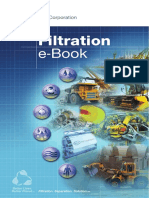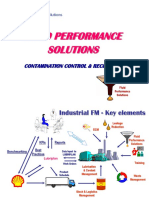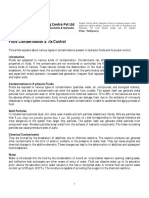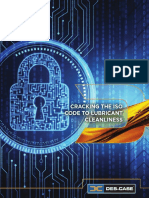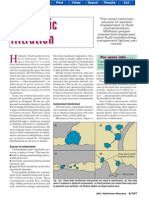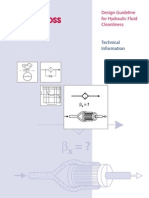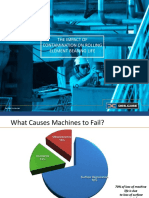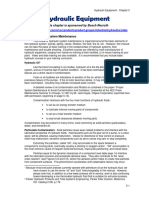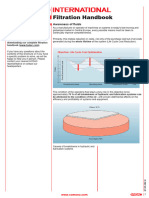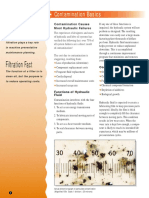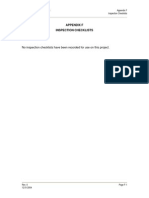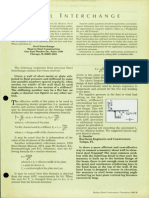0 ratings0% found this document useful (0 votes) 54 views31 pagesContamination Control and Filtration Fundamentals
Copyright
© © All Rights Reserved
We take content rights seriously. If you suspect this is your content,
claim it here.
Available Formats
Download as PDF or read online on Scribd
SONTAMINATION
CONTROL AND
@ “FILTRATION
; FUNDAMENTALS
PALL INDUSTRIAL HYDRAULICS COMPANY�Pall Industrial Hydraulics
Company
PALL INDUSTRIAL HYDRAULICS COMPANY
CONTENTS�Equipment Life Ex
Feeae ane
Presented tthe Amencan Soy of Lircaen Engheers Bening Wosshp, 1961
Sources of Contamination
Built in contaminants from components: External ingression:
s, fluids, hoses, hydraulic
1nd pipes, pumps, reservoir :
tc * Bearing s¢
Generated contaminants: Contaminants introduced during maintenance:
Micrometer
,
The
um
Small
Thickness
dot you can see with the naked eye ~40 um §
sheet of looseleaf note paper=75 wm
The mi:
particulate contaminants in lubricating
r systems. Horan rer). partes (Hoy) a 10 (ison
Fluid Functions
Transmits power
* Reduces friction between components
© Separates wearing surfaces
spends contaminants
-omponent oxidation
Provides cooling
LUBRICATING FLUIDS FUNCTION BEST
WHEN CLEARANCE SIZE PARTICLES ARE CONTROLLED�Fluid Analysis recreate ema
requirements. Th mit f system and
lethods oe eat mc caa ee eee
Method i = Benefits Limitations
Optical particle count Numberimi Provides accurate size Sample preparation time.
mee eeeecenl | emer Roc | eee
[centration and non-par-
ticulate contaminants. eg
H50, air, gels
Patch test and fuid
Visual comparisord
Rapid analysis of system
Provides approximat
lergelsmall particles
on which wal indieate
the need for more sophis-
ticated testing upon
‘abnormal recut,
Contamination Cleaniiness code fid cleanliness levels in| contamination
comparator field. Also helps to identily
types of contaminants.
‘Scaled number of Provides basic informa- | Cannot deter
tous parties
Jcopper, silica. e
Identites and quantifes
{Contaminant material
[Cannot size conta
ants; limited sensitivity
above Sum.
Inckcates total amount of
Contaminant
[Cannot distinguish parti
[cle size. Wnen compar
ing samples, sensitivity
limited to extremely large
itferences in partculate
level�e Measuring Particulate
Contamination Levels�Pall Cleanliness Code
8 88
uae Bel
Pall Cleanliness Code:
16 / 14/ 12
=
4
i
5
=)
i
7
0
5
4
i
a
1
|
9 15 2 2% m0 owas
Pari Se, mczometers
Particle Count Summary
Particle | Number per ml
Size_| greater than size
2um | 430.00 16 |—
Sum 90.00 7
40m 44,00
15m 21.00 oa
25m 3.00
50 um 0.50
The Pall Cleanliness Gode references the
number of particies greater than 2,5 and 15
microns in each milter of uid, The results
of particle counting are plotted on a graph
(Ghown at left), The corresponding range
Code, shown at the right of the graph, gives
the cleanliness code number for each ofthe
three particle sizes, The Pall Cieanliness
Code is an extension of the ISO Cleanliness
Code (IS04406/SAEJ 1165). By including a
range code for particles greater than 2 wn
in Size, it provides an estimate of the sit
level (1-5 um) in the fluid sample.
“Note, Each increase in range number represens 8
‘doubling othe contamination level�® Contamination Level i
Comparison can
Harmful clearance size particles can be effective- ke a
¥ contrled only wih igh performance clear ‘
ance protection fiaion aa
Number of Pall _
Photomicrograph (100x mag.) Description Particles/mi Cleanliness Code |
os
ee
Yum Gori to Banas | 7
Newolrombaret > 293,123 {@
313 S010 za20ne es.
318 Bato =
e a
2 T9858 a
baitin See am
taminants 20 5
ar : >15 8.228 =
pina pee ;
pocreute 310 1,800 ana
pa g a
ee: mn
eee...
ae ee�Mechanisms
of Wear
Each of these wear mechanisms results in the generation of particulate contamination capable of
causing further component damage.
Abrasive Wear
Abrasive wear effects:
‘Dimensional changes pane
‘Lower efficiency
‘© Generated panicles=more wear
Abrasive wear is the primary wear mechanism,
Size range must be removed.�® ~~ Pump Wear
temperatures, lower oll pump pressures and
reduced efficiency
PUMP, GEAR
Cylinder Wear�2g
Erosive
Wear
Erosive wear effects:�e Fatigue Wear
Bearing surfaces are ted to fatigue failures stressing by the bearing load even without
i ut of repeate g caused by ‘additonal particulate dar tualy the
rapped by the two moving surta surface fails, producing amination
aces are
and cracking is reduces bearing ife significantly through fatigue
read after repeated abrasion, and roughening of operating surtaces
Bearing Wear
ae ae
2 operating or dynam
Clearance (im) _
the bearing but
speed, and lubricant 05-100
O43
125
Reference: ASME Wear Handbook�Valve Wear "
Wunder arralcrsrdhe
Typical valve dynamic clearances Clearance size particles cause
”
Valve Shifting Force vs.
Contamination in Fluid
Crem of SCC are
|
p ;�@ Breaking the Chain Reaction
of Wear
a3 @=200)�Chain Reaction of
Abrasive Wear
Particles generated as a result of abrasive wear
are work hardened, thus they become harder
than the parent surface and, f not remioved by
proper firation, wil recrculate to cause additional
‘wear, This “chain-reaction-ol-abrasive-wear” wil
continue and result in premature system
‘component failure unless aclequate fitraion is
‘applied to “break the chain”�NADC Piston Pump
Wear Test
This 3000 psi piston pump test shows clearly the
dramatic wear-reducing benefit of clearance
[protection fitration. The test was run in two, 250-
hour phases with and without ingressed
contarrinants, During the second phase, AC Fine
Test Dust (ACFTD), carbony/ iron, and AC Coarse
Test Dust (ACCTD) were added to the flowstream,
The report concludes that the dominant wear
mechanism causing weight loss on four internal
‘components was hard particle abrasion between
siding surfaces,
Bearing Fatigue
Life Extension
Clearance protection fitration has a significant
cect on bearing lfe. A study directed by Dr. P.B.
‘Macpherson, United Kingdom, demonstrated the
relationship between the control of clearance size
particles and the relative fatgue life of roling
‘contact bearings. Tests on roller bearings showed.
that as the fiter rating decreases from 40 pm
down to 3 um, bearing fatigue Ife increases,
‘exponentially,
FELATVEWEARRATE
RELATIVE WEAR RATESIAVERAGE OF
FOUR HYORAULIC PUMP COMPONENTS.
-FATRATION LEVEL MICROMETERS�Results of Clearance
Protection Filtration
‘Component
Extension of 1
SON of fd fe and
Costs trough reduced co
ndation i�;
in Oj
Water contamination in fluid systems cause:
* Fluid breakdown, such as additive precipitation
d oll oxidation.
duced lubricating film thickness
ted metal surface fatigue
sion
‘Jamming of components due to ice crystals
1d at low temperatures
of dielectric strength in insulating fluids
Sources of water contamination:
Heat exchanger leaks
al leaks
fensation of humid air
* Inadequate reservoir covers
‘* Temperature drops: dissolved water to
Forms of water in oil:
‘Free water (emuisified or in droplets)
* Dissolved water (below saturation)
Free and dissolved water cause component and.
oil degradation. When oil becomes milky in
appearance, the saturation limit at the of
mperature has been exceeded, indicating that
both dissolved and free water are present
aac and Air Contamination
Dissolved air and other gases in oils cause:
oaming
‘Siow system response with erratic action
‘+A reduction in system stiness
* Higher fluid temperatun
‘« Pump damage due to cavit
«Inability to develop full system pressure
* Acceleration of oll oxidation
Water measurement techniques:
* Crackle test (tree)
* Centrifugal (free)
* Karl Fischer (free and dissolved)
* Distilation (ree and dissolved)
Typical oil saturation levels:
‘* Hydraulic - 200-400 ppm (.02-04%)
‘Lubrication = 200-750 ppm ( 02-07%
‘Transformer -30-50 ppm (.003-.005%)
~ Pages machine whe yp here « DE
A Mikes im the aC,
2 drweltrn dase to umber
pe ae
yer could
t
DISSOLVED WATER
ste
0 @ 0 @ 0/00 mo wo 0) 00 20
OL TEweRATURECT)
‘ema ranartd ected aon
Bolepisclrowowihe oteaurson potas esse�Effect of Water on.
Bearing Fatigue Life
orn lett alfiteras
HED Zon 498
SAE | 100 ppm 182
oa |
Effect of Water and Metal Particles
on Oil ee
two tests show the dramatic catalyzing
ler exerts on pump performance and
he gear purnp case itis evident water
performance. With the vane pump tes,
ni ieracs wih the water 1 cause
Relerence: Fusd Power Research Centr, Olahoma
EP additives aduces obhaadve
weer Cal com ineware abraive
Wear if the Lilteebinn in male done
propels
6
WA vincent TAP
toe ear Ta
o| Ba 0 leluaiorskirn
Totar*
Gear Pump Wear with Water and
(Reduction in volumetric efficiency after 30 minutes),
Dry tic
Flug plus 10,000
ppm water (1%)
Vane Pump | with Water.
(Component Weight Loss ms)
°
|
Contaminant
Test Onx ‘oy
Dry fsa 0 40
Flud pls
500 ppm water 190 28,500�# Common Methods for
, Water Removal
Vacuum dehydration is
Coalescence
e y removal at minimum c
Centrifugation
Free
Absorption
Vacuum dehydration
Free and dissolved water, good for unit and bulk
eot that the vacuum dehydration method
1.240 466 34
rernaii1 nant 1413
Code)
Retorence: SAE Paper 840716�High Performance. ®
Element Construction�Tapered Pore vs.
Uniform Pore Medium
‘Tapered pore design
design allows users to reduce
maximum particle
ie
cellulose and glass fit
size, but made with thick
LrsrMmoTO sax�Importance of Fiber Size © |
Biv
Bil J
Ey
a
Benefits of smal fiber diameter: Benefits of inert inorganic fibers:
+ More pores for higher dirt capacity + No chemical reactions or sweling
‘More pores for lower AP * No she if tations
Fixed Pore vs. Non-Fixed Pore Media ®
In fixed pore media, fibers are bonded with spe- fibers under pressure and flow sur
Cially formulated resin to resist deterioration from particles to pass through the medi
pressuro, flow fluctuations, temperature and age. also break loose and pass into the syster
Fibers in non-fixed pore media are inconsistently 2dtional contamination.
‘or poorly bonded. This facltales movement of
CREE NON-FIKED PORE MEDIUM�Filter Elements
‘SECTION OF SUPPORTED FILTER ELEMENT
Supported vs. Unsupported
Measuring Filter Performance —
Filter Ratings
arbitrary mic
cent removal y
5 Due to lack of reproducibil:
ig is deprecated
ting - The diameter of the largest
Je that will pass through a f
Fil
ed test conditions. This is an indi
jest opening in the filer element.�The Multipass Filter
Performance Test
ans 10 Ob. Penisov4s72 MoOIED
WITH ON-LINE PARTICLE COURTING
” —_
4 :
von Pex,
eS)
en (ore ,
Beta (8) Ratio
Beta ratio�Beta Ratio vs. Particle Size
A stoop Beta curve profile
ne tes a medium with oa
consistent, slable pore sttucture and
high beta performance across the pobre
iedparice range Flatercuves FAT
ative of media with
pore structure and lack of
ver the particle range.
ermine fiter rating, particles at
nicron sizes are counted
FUIRATONRATIO.8
EE
Talos are graphed and tho }
where the plotted data B
= 200, becomes the fiter
PARTICLE SIZE, nm
Beta Ratio and Downstream Fluid Quality
uid downstream of 8, 2 200 (99.5% efficiency) filer is 2.67 times cleaner for particles > x microns
than a 8, 2 75 (98.7% eficiency) fier.
oHER DETALLES
Satine” RUTERRATO. CONMESTREAMFLUD QUALITY
. GRE
Bearers ueeerrercemraeinene r,
lente�Effect of Cyclic/Surge Flow and
Pressure Drop on Beta
Cyclic or surge flow, and increasing
filer pressure drop can degrade fil
ter performance dramatically unless
the fiter is property designed to
resist this acton. Such design
involves medium support and resin
bonding, as well as smaller pores.
Service Life vs. Dirt Capacity
Defiitions of service life and dirt capacity are given below. Dirt capacity should not be used to
fiter Service life due to the many variables that affect dirt capacity data,
‘Service life is the length of tme that afiter will
‘Survive in an actual system before the terminal AP
‘is reached,
Apparent dirt capacity isthe amount of dit that
‘can be added to the fiter test system before the
terminal AP is reached.
Retained dirt capacity is the arnount of dirt that is,
Caplured by the fiter in a test system before the
terminal AP is reached,
0 predict�@ Dirt Capacity from
I the Multipass Test
((SO 4572, ANSM(NFPA)T3 108.81 Comparing dirt capacity of two elements
‘Test variables that affect capacity data + Al variables above must be equal
* Elements must be of equivalent size
include:
«Flow rate. '» Elements must be of equivalent efficiency
'* Contaminant © Retained dirt capacity values must be
| « Contaminant ingrossion rate compared
: * Multipass vs. single pass
; ‘+ Terminal pressure drop
! « Fiter ntognty
| Dirt capacity would appear to be an easy service lives. For example, coarser filters with
parameter io measure and understand; however, higher dit capacities wil allow more particle
Using dirt capacity to predict service life is quite generation because of wear. They generally have
i difficult. Two different fiters with the same dit shorter service if than fine fiters.
i capacity will almost always have quite different
maanae iy annr lice
® Contaminant Loading Curve
1 As din is rapped by the fiter, differential pressure relief valve opens. The bypass valve protects the
(AP) increases. A differential pressure indicatoris _fiter and system from excessive ditferential pres
Used to signal element change before the bypass sure andlor element collapse.
B loyesn of indtcalors :
Fobicaler
To p52 25 pork
asad Sopa
2 Non bu
lee psi es
) + 1h psiB i> ual om
See
»
lw�Filter Placement
Filter Flushing
To remove contaminants that will cause
calastrophic fares
+ To remove wear causing particles prior 10
system start up
* To extend “in-service’ iter element Ife
Pressure Line
* To stop pump wear debris from traveling
through the system
'. catch debris from a catastrophic pump
failure and prevent secondary system
damage
‘*To act as a last chance fiter to keep dirt out of
circuit
Return line
‘To capture debris from component wear or
ingression returning from circut
* To promote general system cleanliness
Ou Transer
PLTERCART
= Spe 2,
Air breather
* To extend filter element service life
‘© To maintain system cleaniine
Kidney loop/off-tine
* To control system cleanliness when pressure
line flow diminishes (ie. compensating pumps)
+ For systoms where pressure or return frat
impractical
© AS a supplement to in-ine filters to pr
improved cleanliness control and filter
service Ife in high din ingression syste
‘Additional filters should be placed ahead of
critical or sensitive components.
* To reduce wear
* To stabilize valve operation
(prevents stiction)
* To protect against catastrop!
(often non-bypass fiters are used)
mr
nessun
RONEY
TOOROFELINE
FLIER�Importance of
Proper System Flushing
Almost all reliability studies acknowledge the
oathtud” curve of failure probability shown at right.
‘© Region | includes failures which are low hour
(infant mortality’) failures occurring during
system start up.
‘+ Region Il falures are normal-reliability
distribution failures,
‘* Region Ill represents wear-out failures.
H\ )
ci
=
Li
9
a
a
ag
WW
=|
re
ToS 2
[EFFECT OF BETARATING ON FLUSHTIME
CLEAN-UP RATETO REACH 0 PARTICLES 5M
ro0oc000 fF
DOWNSTREAM PARTICLE COUNTS
RELATE CLEAN-UPTIME
fs hsrad abo, idler raw
feibtencn Yee on
‘Bm a3 reste an
fe zotaaon
ranncom oi ome ce,
a St assumed io be 1000000 partes I>5 microns.
cerprescnenmnga ted
ames =
see
a�System Component ¥—
Propontonal valve a | 8 Ca
[Varabie vaume pune A
Carriige valve
Fed pasion puro A
Vane pum
Pressuefiow conwol valve |
Solero vale
Gear pump
>|>|>|>]o|o
| a|o]o
m|m|m|m
Ball bearngs ala
Roller bearings
Jounal beanngs
Gear box (industrial)
Gear box (mobile)
Diesel engine ale
(Cleanliness level (PCC) sanar | ranve | warano | wyatt | sorane | renee | rena | rena
Pal Fiter KP |
Meckum Grade ay | |
To determine system cleanliness level fematonan
1. Start at the top of the system components list. Find the first item Pressure Range (psi)
oc nau neieas enone ay >=
2. Locate box'o he rot ot he selected component which en
coresponds ote Operaing pressute ange [Ba 15000
3. Recorrended ceaniness levels oven athe botom ofeach [Ea <'s00
4. Shit one column othe let any of he folowing factors app
peor NF Lubrication System
producton rn
High cycelsevere duty appicaton Sara me ang
Water Contanng hycrauie td's used Eomecotust cer
4. Systems expected tobe n sence mere than seven years Ce Misinos sen
© System alse can create a salety concer�e
Total Cleanliness Control





